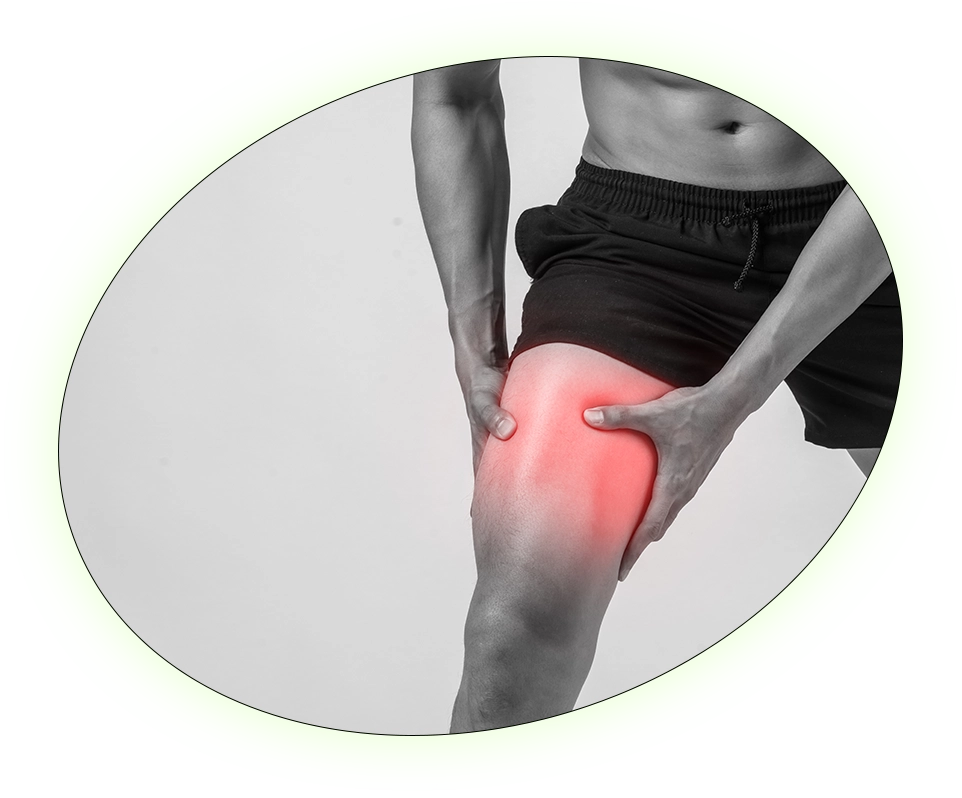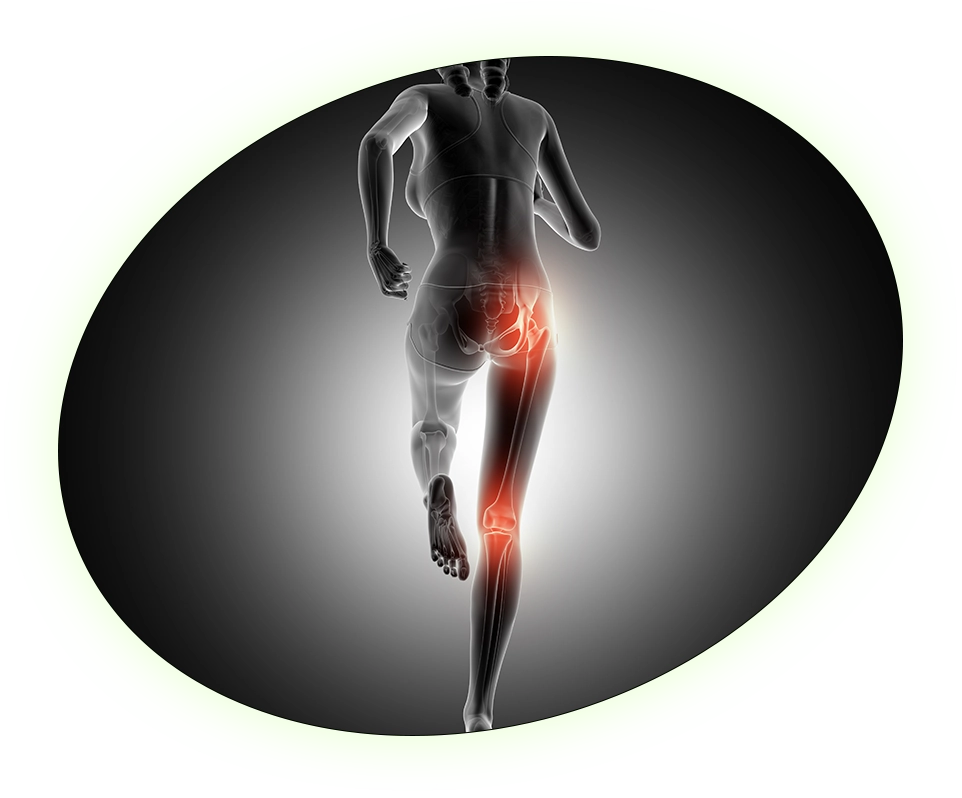Hips, Legs & Knee Pain
Hip, leg, and knee pain can disrupt every aspect of your life, from simple movements to daily activities. Whether it’s a sharp pain, persistent aching, or joint stiffness, discomfort in these areas can limit mobility, reduce strength, and lead to long-term complications if left untreated.

Pain in these areas is often caused by injuries, overuse, joint degeneration, or nerve compression. It may develop from repetitive movements, muscle imbalances, or underlying medical conditions. Understanding the root cause is the key to finding long-term relief.
Arthritis and joint inflammation cause cartilage breakdown, leading to stiffness and pain. Overuse and muscle strain from prolonged standing, running, or improper movements can also contribute to discomfort and reduced mobility.
Nerve Compression & Sciatica: Pinched nerves radiating pain from the back to the legs.
Ligament & Tendon Damage: ACL, meniscus tears, or tendonitis affecting stability.
Poor posture, improper walking form, and muscle imbalances can lead to strain and discomfort, affecting movement and overall joint health.
Pain is your body’s way of signaling a problem. Ignoring it can lead to permanent joint damage, reduced flexibility, and chronic conditions that worsen over time. The good news? You can take action now to prevent further damage and restore movement.
Hip, leg, and knee pain can worsen over time if ignored. Weak muscles and poor movement increase strain, but small adjustments can protect your joints and prevent long-term damage.

It’s not just discomfort—it’s your body warning you of joint stress, inflammation, or nerve issues.

An issue in one joint can trigger pain in another due to compensatory movement.

Poor muscle support leads to instability and overuse injuries.

Arthritis, mobility loss, or nerve damage can develop over time.

Poor posture, improper walking, and excess pressure on joints can worsen symptoms.

Strengthening, stretching, and modifying daily habits can protect your joints.
Hip, leg, and knee pain can develop from injuries, aging, poor posture, or biomechanical imbalances. Here’s what might be behind your pain:

Joint deterioration causing pain and stiffness.

Inflammation leading to sharp pain and reduced mobility.

Structural damage impacting knee stability and function.

Pinched nerves causing pain, numbness, or tingling down the legs.

Every Step Shouldn’t Hurt
Hip, leg, and knee pain doesn’t just slow you down—it makes everyday tasks difficult, frustrating, and exhausting. Without intervention, pain can lead to permanent mobility issues and joint deterioration.
Your pain doesn’t have to control your life—take action now to prevent further damage!
How to Relieve & Prevent Pain in Your Lower Body

Build stability in your hips, glutes, quads, and hamstrings.

Stretch regularly to maintain joint range of motion and reduce stiffness.

Avoid placing excess stress on your joints by improving your gait.

Reduce inflammation and provide joint cushioning and stability.

Chronic pain should be addressed before it worsens—get expert advice.
Here are some of the questions that we are asked most frequently at Total Spine and Wellness
Regenerative medicine aims to replace damaged tissue or organs caused by factors like age, disease, trauma, or congenital issues, as opposed to focusing solely on symptom management. This is achieved through the use of tissue engineering, cellular therapies, medical devices, and artificial organs.
By combining these approaches, we can enhance our body’s natural healing process where it is most needed. Regenerative medicine brings together experts from various specialties who wish to be on the cutting edge of medicine.
When our bodies are injured or affected by disease, they possess an innate ability to heal and defend themselves. What if we could harness this inherent power and accelerate the healing process in a clinically relevant manner? What if we could aid the body in healing more effectively?
The promising field of regenerative medicine strives to restore the structure and function of damaged tissues and organs. It also aims to develop solutions for organs that have sustained permanent damage. Ultimately, the goal of regenerative medicine is to create transformative healthcare solutions that could potentially help injuries and diseases that were previously deemed untreatable.
Stem cells are undifferentiated cells in our bodies that have the remarkable ability to develop into various types of specialized cells. They can divide and renew themselves to form more stem cells or differentiate into specific cell types, such as muscle, nerve, or blood cells. Stem cells play a crucial role in the development, growth, and repair of tissues and organs in our bodies. They hold great potential for medical research and regenerative medicine, as they may be used to treat a wide range of diseases and injuries.
Stem cells have the remarkable ability to develop into different cell types in the body and can also repair damaged tissues. When introduced into a specific area, they can promote healing through various mechanisms. Stem cells can differentiate into the desired cell type, replacing damaged cells directly. They can also secrete growth factors and proteins that stimulate the surrounding cells to regenerate and repair themselves. Additionally, stem cells can modulate the immune response and reduce inflammation, creating a more favorable environment for healing. These combined effects make stem cells a valuable tool for treating degenerative conditions.
Mesenchymal stem cells (MSCs) are a promising source for the treatment of OA due to their multipotency for differentiation into chondrocytes and their ability to modulate the immune system.
These surgical procedures are considered part of a physician’s practice of medicine, allowing both the physician and patient to freely consider their preferred treatment options. While the FDA does provide guidelines for the treatment and manipulation of a patient’s own tissues, Total Spine adheres to these guidelines by offering same-day treatment using the patient’s unaltered cells, which are inserted during the procedure.
Not everyone is a good candidate for stem cell treatment. We offer a complimentary consultation and imaging review to determine if someone is likely to benefit from our treatments. If the severity of the condition is too great and a successful outcome is not likely, the patient will be told that in consultation.
We are a team of highly specialized spine surgeons dedicated to pioneering the future of spine care.